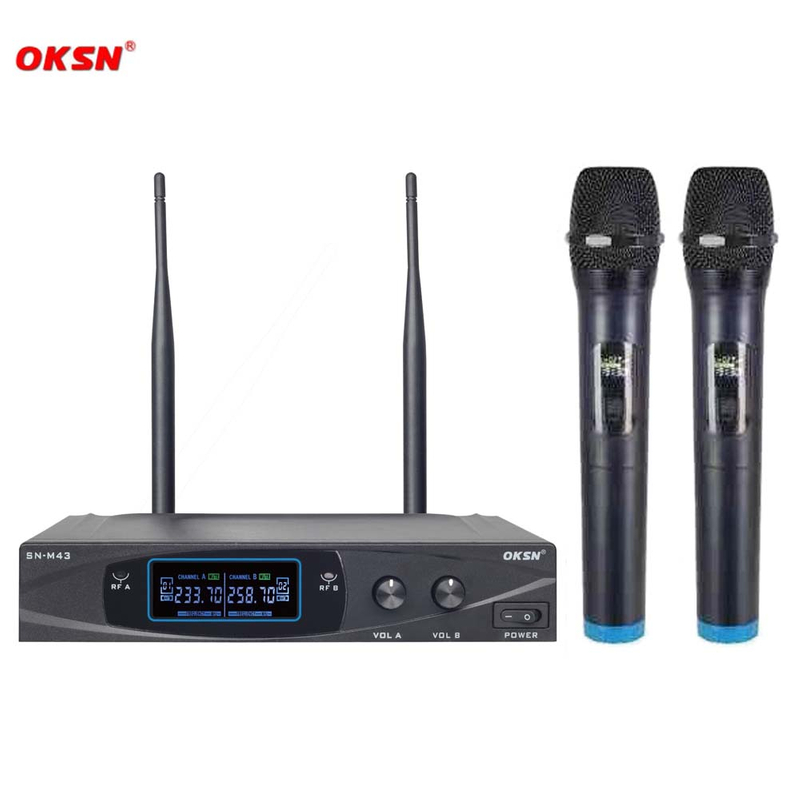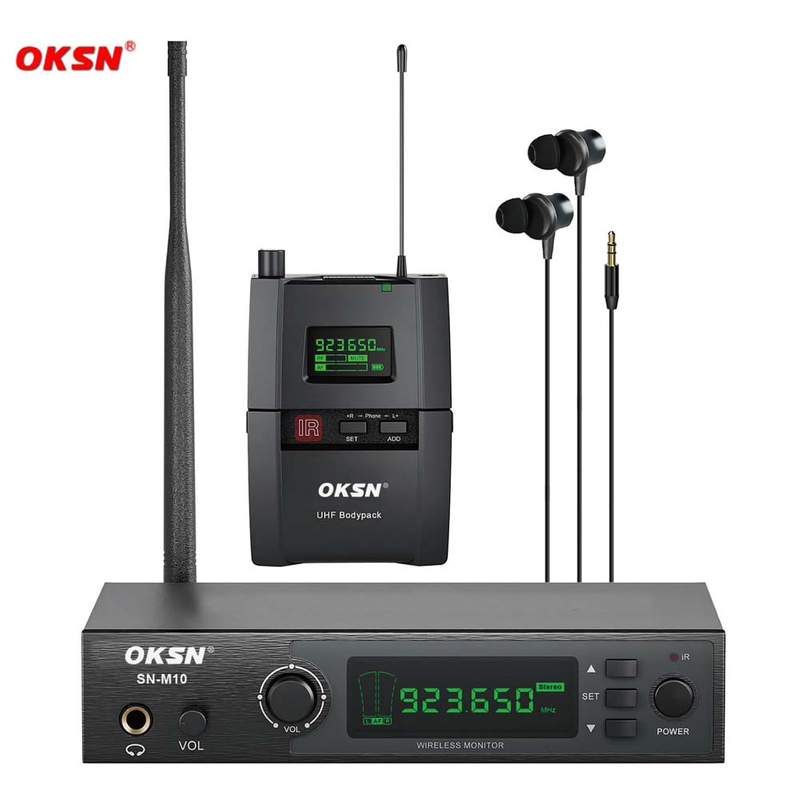- All
- Product Name
- Product Keyword
- Product Model
- Product Summary
- Product Description
- Multi Field Search
Views: 5 Author: Site Editor Publish Time: 2025-03-31 Origin: Site
When it comes to audio tools, microphones are essential for many settings, from stage performances to business presentations, fitness classes, and even karaoke. If you've been on the hunt for the perfect wireless microphone system, you've likely come across VHF wireless microphone systems. But what makes these systems stand out, and how can they benefit you?
This guide will break down everything you need to know about VHF wireless microphone systems, how they work, their advantages, and what to consider when choosing the right one.
A VHF wireless microphone system is a type of audio setup that uses VHF (Very High Frequency) signals for transmitting sound from a microphone to a receiver without the need for physical cables. These frequencies typically range from 30 MHz to 300 MHz and are divided into various bands used for different purposes, including audio transmission.
Essentially, VHF wireless microphones allow performers, speakers, and presenters to move freely without being restricted by cables while ensuring clear audio transmission.
Here’s a simplified rundown of how it works:
△Microphone Captures Sound
Whether it’s a handheld, lapel (lavalier), or head-mounted mic, the microphone captures the audio signal from your voice or instrument.
△Signal Transmission via VHF Frequency
The signal is converted into a VHF frequency and wirelessly transmitted to a nearby receiver. This is achieved through a small transmitter built into or connected to the microphone.
△Receiver Converts Signal Back into Audio
The receiver picks up the signal, decodes it, and sends the audio to your sound system, such as speakers or mixers, for amplification.
The result? Seamless, wireless sound transmission.
New to the world of audio equipment? Here’s why VHF systems may be the right pick for you:
For users on a budget, VHF systems are typically more cost-effective compared to their UHF (Ultra High Frequency) counterparts. This makes them a popular choice for beginners, small businesses, or casual users who want professional-quality sound without breaking the bank.
VHF wireless microphone systems are incredibly easy to set up and operate, making them ideal for anyone who’s not a technical audio expert. Simply plug in your receiver, power up your mic, and you’re good to go!
VHF signals can travel well within a range of approximately 100 feet to 300 feet, making them perfect for small to medium-sized venues such as classrooms, conference rooms, wedding halls, fitness studios, or houses of worship.
Ideal for vocals and speeches, VHF systems deliver clear and warm sound when used in environments free of heavy interference. They work exceptionally well in controlled, indoor spaces without competing wireless signals.
Not all wireless microphone systems are created equal. To make the best choice, keep these factors in mind:
First things first, ask yourself:
Where will I use this microphone?
If you’re speaking at a school or small church, a single-channel VHF system will suffice. However, musicians or DJs may require multi-channel systems to support multiple mics and instruments simultaneously.
What is the environment like?
If your venue is in a busy city or has many radio frequency devices, interference could be a concern (though we cover interference solutions later).
VHF wireless systems come with different microphone styles:
Handheld Mics are great for singers and public speakers.
Lapel/Lavalier Mics clip discreetly to your clothing, making them ideal for presenters or fitness instructors.
Headset Mics provide hands-free options for active users, like those in performing arts or coaching.
Choose the type based on your specific needs.
Since VHF frequencies are used by various devices like radios and televisions, interference may occur in urban areas. Look for a system with multiple frequency options, allowing you to switch channels in case of signal overlap.
Always consider battery life when opting for a wireless microphone system. VHF wireless microphones generally have a decent lifespan, but investing in rechargeable batteries or systems with power-efficient designs will enhance usability.
Durability matters, especially for live performances. Opt for a microphone with a solid build that can withstand accidental drops or frequent use.
If you’re someone on the go (e.g., a traveling speaker, trainer, or performer), consider lightweight systems that are easy to pack and transport from one venue to the next.
Some premium VHF wireless systems include advanced features like:
Dual/multiple-channel capabilities for running several mics at once
Noise-canceling to reduce background noise
Built-in equalizers for instant sound adjustments


Getting the most out of your VHF system isn’t just about purchasing the right equipment; it’s also about proper setup and usage. Here are tips to guarantee top-notch performance:
Scan for open frequencies to avoid interference, especially in crowded areas.
For the best connection, ensure there are no physical barriers (like walls or metal objects) between the microphone and receiver.
Avoid placing your receiver next to other electronic devices, such as Wi-Fi routers or Bluetooth equipment.
Clean your mic after use, replace batteries promptly, and inspect cables and connectors to prevent disruptions during important events.
Always test your equipment before the event starts. A quick soundcheck can help identify and resolve potential issues ahead of time.
VHF wireless microphone systems are a fantastic choice for those who need reliable audio without the complications or high costs associated with other systems. Whether you’re hosting a karaoke night, leading a fitness class, or delivering a keynote speech, these systems offer an affordable and effective solution to your audio challenges.
However, if you’re planning to use your microphone in a large venue or in an area with many competing wireless signals, it may be worth exploring UHF systems for improved range and versatility.
Choosing the right wireless microphone system can truly transform your events and performances. By investing in a VHF wireless microphone system that matches your specific needs, you’re on your way to delivering exceptional audio with freedom and confidence.
Want more tips on upgrading your sound setup? Keep exploring our blog for equipment reviews, guides, and the latest in audio technology.
Exhibition Name: The 124th Canton Fair Booth number:5.1 L31 Date:15-19 Oct. 2018 Address: China export&import commodity exhibition center ( Pazhou pavilion)
Dear Sirs /Madam:We hereby sincerely invite you and your company representatives to visit our booth at the Canton Fair from April 15th to 19th on 2019.It would be a great pleasure to meet you at the exhibition .We expect to establish long-term business relations with your company in future .Exhibiti
OKSN Electronics Technology Co. Ltd.was established in 1997. It lies in the microphone production base--En'ping City, Guangdong Province, China.Our factory is a professional manufacturer for microphone integrated with designing,investment,produce and sell. The products include wire/wireless microp
A productive meeting hinges on clear communication. When participants struggle to hear each other, ideas get lost, decisions are delayed, and frustration builds. While many factors contribute to a successful meeting, one of the most critical is audio quality. A high-quality conference room mic ensur
Finding the right singing microphone can feel like a daunting task. With countless options on the market, each promising pristine sound and flawless performance, how do you know which one is truly the best for you? The microphone you choose is an extension of your voice, and the right one can elevat
Finding the right power amplifier is crucial for achieving high-fidelity sound, whether you're setting up a home theater, a professional studio, or a live performance venue. For decades, manufacturers in China have been producing a vast array of audio equipment, including power amplifiers that cater
A great microphone can make or break your content. Whether you're filming a YouTube video, recording a podcast, or presenting on stage, clear audio is non-negotiable. While traditional wired mics have been a reliable choice for decades, wireless mics offer a level of freedom and flexibility that can
Karaoke is more than just a pastime; it's a global phenomenon. At the heart of every great karaoke night is a reliable, high-quality microphone. Many of these microphones originate from China, a global manufacturing hub known for producing a vast range of consumer electronics. If you've ever conside
Sourcing electronics from China can be a highly effective strategy for businesses looking to scale production and access a wide range of products. The country's manufacturing ecosystem is vast, offering everything from basic components to sophisticated professional audio equipment. When it comes to
Tangled cables are the enemy of any dynamic performance, presentation, or recording session. They restrict movement, create trip hazards, and can be a visual distraction. A wireless microphone system solves these problems by providing the freedom to move without being tethered to an audio mixer or c
Clear, reliable audio can make or break a performance, presentation, or production. While wired microphones have long been a dependable choice, they often come with the literal baggage of tangled cables and restricted movement. For true freedom and professionalism, many are turning to a more flexibl
In the world of content creation, filmmaking, and live performance, pristine audio is not a luxury—it's a necessity. While a high-resolution camera captures stunning visuals, poor sound quality can instantly detach an audience and undermine your message. This is where a professional wireless microph
In the world of audio capture, clarity is king, but mobility is the power behind the throne. Whether you're a presenter commanding a stage, a filmmaker capturing a cinematic scene, a educator engaging a classroom, or a content creator speaking to a camera, the tool that grants you both is the wirele
Untethered, unrestricted, and crystal-clear—a quality wireless microphone system can transform any performance, presentation, or production. But stepping into the world of wireless audio can feel overwhelming. With terms like UHF, VHF, latency, and diversity floating around, how do you choose the ri
Recording clear, professional audio starts with understanding your microphone's most critical component. The dynamic microphone cartridge sits at the heart of every dynamic mic, converting sound waves into electrical signals through electromagnetic induction. Whether you're a podcaster, musician, or
In the world of professional audio, clarity and reliability are non-negotiable. For performers, speakers, and content creators, a poor audio signal can ruin a presentation or performance. This is why choosing the right microphone technology is so important. One of the most trusted solutions in the i
In public spaces—whether auditoriums, schools, corporate halls, or outdoor venues—delivering clear, audible speech is essential for effective communication. A public address (PA) system wireless microphone eliminates the limitations of wired microphones (e.g., tangled cables, restricted movement) wh
The evolution of the microphone from a tethered, stationary device to a dynamic, wireless instrument has revolutionized audio performance and presentation. A wireless microphone mic system (often shortened to "wireless mic system") unlocks a world of movement, engagement, and clean stage management,
Choosing the right audio mixer is a pivotal decision for anyone serious about sound, from podcasters and live streamers to musicians and live sound engineers. A great mixer is the heart of your audio setup, shaping your sound and ensuring every element is heard exactly as intended. Among the many br
Great content often starts with great audio. While stunning visuals can capture attention, it's crystal-clear sound that keeps an audience engaged, builds trust, and delivers your message effectively. For content creators, filmmakers, journalists, and presenters, achieving professional-grade audio o